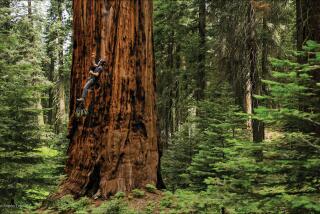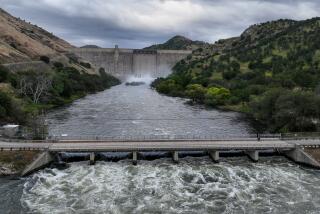Inventory of Species Could Keep Them From the Brink : Nature: Surveying wildlife can show which creatures are in trouble, where they are, and how to save them.
Five years ago, a researcher reported that the striped skunk had vanished from Sequoia and Kings Canyon national parks in California. The animal was just one of many the researcher said had become extinct in Western parks.
The Park Service was horrified--not because it believed it was losing all these animals, but because it realized it really had no idea what it had and what it didn’t. Worse, many of the reported extinctions were based on Park Service information that turned out to be just plain wrong.
In Sequoia, for instance, the researcher used a park inventory consisting of visitor sightings of animals. No visitor had bothered to mention seeing the skunk because it was so common, so ordinary.
“Visitors don’t turn in skunks,” said Charles Van Riper III, a research scientist for the Park Service.
The Park Service, the caretaker of the most scenic sites in the nation, is not alone in its ignorance. The United States has no complete inventory of its species, nor, for that matter, does the rest of the world.
Some scientists credit Australia and New Zealand with strong inventory efforts, but no nation has accumulated the kind of details many researchers seek.
They want to know of the existence, characteristics, numbers, condition and location of plants, animals, insects and other organisms, and how they depend upon one another. At the very least, they want to keep track of animals, plants and butterflies.
Without a more thorough survey of wildlife, scientists say they cannot know with certainty which species are in trouble, where they are, how to save them, how to use them in medicine or industry, or, should habitats disappear, how to try to restore them.
So little is known about species diversity that a child in Los Angeles who collects bugs “has a very good chance” of discovering a tiny insect that does not yet have a scientific name, according to Peter H. Raven, director of the Missouri Botanical Garden and home secretary of the National Academy of Science.
“We are perfectly willing to accept the idea that astronomers could spend billions of dollars to give us colored photographs of celestial objects that are of no use to us,” said James Quinn, a conservation biologist. “Yet we find it difficult to argue that we should have as least as much wonder of the things that are outside our back door.”
With human population rising and wild places declining, time is running out for recording what is here before it is gone.
“In many ways we have an opportunity now comparable to that of living in the terminal decades” of the dinosaurs, Raven said. “The opportunities that exist to sample the full range of (natural diversity) with which we coexist will never occur again.”
The task is daunting. In addition to flowering plants and vertebrates--which include mammals, reptiles, amphibians, fish and birds--millions of insects, microorganisms and lower plants such as lichens and mosses exist on Earth.
Some researchers estimate there may be a million species each of mites and nematodes, a kind of worm, and only a fraction of them have been named. Some are essential for breaking down organic matter that is subsequently taken up by plants.
There are 69,000 named species of fungi, but scientists guess their number could reach 1.6 million. A scientist in Norway recently estimated that a single gram of soil might contain 4,000 to 5,000 different kinds of bacteria.
Concerned by the dearth of data on U. S. species, scientists and conservationists have launched a variety of efforts to survey the most visible wildlife--primarily stemmed plants and vertebrates.
One of these efforts, dubbed “Gap Analysis,” is designed to provide an overview of the nation’s natural treasures. Its findings may make it possible to safeguard species while they still are common.
Biologists say this is important because wildlife populations can plummet quickly. Species commonplace just a few decades ago are rapidly becoming scarce.
Current law often provides protection only after species are at the brink of extinction. By that time, rescues may require changes in industry that cost people their livelihood.
Using satellite imagery, property records and data on plant and animal distributions, Gap Analysis will show which kinds of landscapes are preserved as parks, wilderness or other reserves, which remain vulnerable to development, overgrazing and logging, and which kinds of habitats shelter which species.
By uncovering gaps in protection, the project will be able to identify species headed for trouble and provide conservationists and government with a guide to places rich in diversity.
“What we are trying to do is provide information while we still have time to make compromises, rather than when we are dealing with the last marginal population of spotted owls, for example,” said J. Michael Scott, a research biologist with the U. S. Fish and Wildlife Service.
The program, managed by the Wildlife Service, intends to survey each of the 48 continental states by 1997. Some Gap Analysis techniques are now being applied to regional development planning in California.
A precursor of the program alerted wildlife officials and conservationists in Hawaii 10 years ago that parks and reserves were not in the right places for protecting the state’s declining forest birds.
The discovery was timely. Officials had been on the brink of acquiring property that maps showed was not particularly important to threatened wildlife. Acquisition plans were changed.
In Idaho, the only state whose Gap inventory is completed, about 60% of the land is owned by the federal government. The survey, however, revealed that only 10% of more than 100 different vegetative communities are protected as wilderness, parks or reserves.
As much as 24% of the alpine and 30% of the subalpine forests--places near or above the tree line of mountains--have been preserved. Such sites are frequently designated as wilderness because they are of little use to industry and have no roads.
In contrast, the survey found that less than 2% of the forests at lower elevations have been set aside for their natural importance.
The species, including birds, differ in each. The lower elevation forests contain more reptiles and amphibians. Grizzlies in Idaho prefer the alpine environment; black bear, deer and squirrels prefer the lower elevations.
“What we’ve got then is a score card, and the score card will tell us how well we have done to date with setting up areas for the long-term management of biological diversity,” Scott said.
The exercise did more than identify landscapes in danger of disappearing. It also revealed ways to shift uses of public lands to better protect them.
Maps showed that “relatively minor” changes on 20% of the federal lands, such as reduced livestock grazing or smaller timber cuts, could safeguard most of the other species there, according to Edward LaRoe, a research director at the federal Wildlife Service.
“We can sit down (with other agencies) and make judgments that we need so much land managed in such-and-such a fashion to protect whatever array of resources we want,” LaRoe said.
Such mapping could shift land acquisition programs away from tracts intended to conserve a single endangered species to places that contain a multitude of wildlife.
The emphasis would be on endangered habitat, such as ancient forests, rather than on specific animals or plants within them.
Said Kent Smith, a biologist and chairman of the national board for the Gap program: “Realistically, I believe we cannot save all endangered species. . . . The next best thing is to save as many species as you can.”
With that in mind, privately funded organizations now are attempting to catalogue and save remnants of plant populations. Plants help cleanse the air and water and influence climate.
Don Falk, director of the Missouri-based National Center for Plant Conservation, said the costs of coping with the loss of plants and their genetic resources, which are important to agriculture, would greatly exceed the price of studying and conserving plants today.
“Plants are the only organisms that convert sunlight to organic matter and (are) the basis of all terrestrial food chains,” Falk said. “It was astounding to me when we started this center (in 1984) that there was not an organization devoted to plants, which are collectively the most important organisms on Earth.”
California and other states already have wildlife inventories that focus heavily on rare or so-called sensitive species, thanks to efforts launched by the Nature Conservancy. California’s inventory is about 60% complete, according to John Ellison of the state’s Fish and Game Department.
So far, the survey has shown that most of California’s aquatic ecosystems--streams and rivers--have been destroyed, primarily by projects diverting water for people.
All the free-flowing streams except one on the western slope of the Sierra Nevada have been dammed, dooming wildlife that depend on them.
To the rare species remaining in the Sierra, livestock grazing, not timber cutting, is the biggest threat to long-term survival, Ellison said.
The findings represent only a smidgen of what is yet to be learned.
Both the Gap effort and the states’ inventories do only limited investigating on the ground. The whereabouts and kinds of animals are often inferred from the nature of the habitats.
Critics of these efforts, including some of the participants, say they are no substitute for comprehensive on-the-ground surveys.
Take the California spotted owl. Until recently, it was widely assumed to be an extremely rare species, much like its imperiled relative, the Northern spotted owl.
But no one had ever really looked for the California subspecies, which, while relatively common now, could be endangered eventually because of dwindling habitat.
“It turns out that when people looked for them, they found thousands of pairs in the Sierra,” said Quinn, an associate professor of environmental studies at UC Davis. “They are probably the second most common kind of owl in the Sierra next to the screech owl.”
Field inventories are often impractical because they can be extremely painstaking and costly--even those examining only a fraction of the species.
In Martinez, north of San Francisco, a group of botanists surveying a newly acquired 328-acre Park Service property recently scoured rolling, wind-whipped grassy hills looking for plants.
One of the botanists, bent on one knee examining the plants around him, quickly identified six species of grass, a native pea, three peas that originated elsewhere and six herbs. An untrained observer simply would have labeled the spot “grass.”
But even with their training, the scientists can provide only a cursory overview of the contents of the oak woodlands. For instance, they could not find a plant associated with a certain butterfly.
“We know it’s here somewhere because we keep seeing the butterfly,” said Stephen D. Veirs Jr., a botanist and leader of a study unit for the National Park Service.
At the base of one oak-studded hill, the researchers hammered an orange-and-white pole into the ground and ran a tape to map out 50 sampling points. The vegetation at each foot was logged by both abundance and height.
Herbs or grasses that were not immediately identified were picked and put in plastic bags for later examination.
But little real rigor marked the exercise. The three scientists were looking at plants exclusively--not the insects that incessantly buzzed and clicked about, not even the birds, foxes, deer, bobcats or raccoons that make the hills their home.
Still, it is a start. After the faulty report of extinctions five years ago, the Park Service has been trying to beef up its inventory.
At Channel Islands National Park in Ventura County, scuba divers armed with measuring tapes go many feet below the surface each summer to count and measure fish and other organisms. The researchers are attempting to monitor the health of kelp forests.
At Sequoia, park staffers use a grid system to survey samples of the park’s plants and animals.
Probing plots at the grid’s intersections, the researchers meticulously identify plants, note the birds overhead and animals within view, and trap small mammals, reptiles and amphibians.
So far, the inventory has uncovered a rodent, two species of bats and about three dozen varieties of plants never before known to exist in the park--and one extinction. The foothill yellow-legged frog no longer survives at Sequoia.
“If you don’t know what you have and you don’t know where it is, you can’t possibly hope to detect it if it’s in trouble and try to manage it,” said David Graber, a park research biologist. “You are simply trusting in luck, and I don’t think luck is good enough anymore.”
When the project, now in the fifth year, is completed in 1995, only one-tenth of 1% of the parkland will have been examined.
“Whenever you take such a generalist approach, you are assured of missing a great deal,” Graber admitted.
The hurdles are enormous. The world does not have enough trained scientists to investigate its biological diversity, and research grants for such disciplines are hard to come by.
But Raven, for one, remains undeterred. “If you want to do something and organize projects, the people will be found,” he asserts.
Legislation is pending in Congress to support a national inventory effort, and scientists have formed a committee to lobby for the creation of environmental research institutes modeled after the National Institutes of Health.
The U. S. Environmental Protection Agency is launching a monitoring system to attempt to measure the effects of pollution on the environment in representative samples of the country. The program, now in the pilot stage, could serve as an early warning system.
Advocates hope money previously spent on the military can now be diverted to the environment.
Gap’s inventory is estimated to cost $18 million nationwide; EPA’s monitoring program runs about $100 million a year. The environmental institutes could cost at least $100 million to establish and three times that to run.
Ultimately, the success or failure of these efforts may boil down to what public officials do with the information they get.
With only 3% of the nation’s land protected as parks or wilderness, the burden will be on other government agencies and private citizens to use their lands in ways that safeguard their natural diversity.
The track record is not good. The U. S. Forest Service has failed to protect old-growth forests, and county governments routinely allow developers to pave over sensitive wildlands.
But at least with inventories, no one will be able to plead ignorance.






